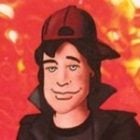If you were to ask someone to name a match involving what were historically referred to as “midget” wrestlers — the term for dwarves that’s generally seen as a slur in 2019 — they would probably go with a bout from WrestleMania III, the biggest card of the 1980s. As was the norm, it was positioned as a lighthearted portion of the undercard, a “mixed” trios tag match where each team featured a conventionally sized wrestler and two smaller counterparts, with everyone only able to legally face their usual opponents. More specifically, King Kong Bundy, the villain who had headlined the previous WrestleMania, was joined by Little Tokyo and Lord Littlebrook, while beloved Hillbilly Jim was flanked by his “little buddies,” Little Beaver and The Haiti Kid. Like most American “midget wrestling,” the match was mostly built around slapstick like Beaver using his slipper as a weapon. (Unlike most, it also featured the very memorable ending of Bundy getting disqualified for slamming and squashing Little Beaver.)
Slapstick was, generally, the commonality between all of the “midget” matches until they fell out of vogue in the 1980s. Common gags included biting opponents on their ass, doing the same to the referee, the referee throwing the wrestlers and other assorted hijinks. And that was about it. Someone might be billed as the “Midgets’ World Champion,” but since they weren’t there to be taken seriously, there was no tangible title lineage that anyone could keep track of. “Midget wrestlers” were there to be a sideshow, just as female wrestlers were in the regional era, and they never stayed put to work full-time in a given area, with both groups instead belonging to centralized troupes that constantly toured North America.
With WWE — then the WWF — going national in the mid-1980s, they set the tone for the rest of the business, and when they stopped booking wrestling dwarves from the leading troupe, led by Littlebrook, that took them entirely out of the mainstream. The “why” of it has been debated: On the one hand, the WWF had carved out full-time roster spots for conventionally sized comedy wrestlers like the Bushwhackers. On the other, Littlebrook has claimed that it was the result of him writing a letter to the WWF office about “Karate Kid” Chris Dube getting sexually harassed, which the company has always denied. Beyond what were usually outside-the-ring roles for Tiger Jackson, who wasn’t part of the Littlebrook troupe, that was it for “midget wrestling” in the WWF, and thus, the mainstream. There would be occasional detours, usually involving dwarves as non-wrestling characters and often showcasing the company’s unfortunate habit of infantilizing dwarves and non-English speakers, but “midget wrestling” as it’s remembered was more or less done in the U.S. at that point.
There have been so few exceptions, especially in the WWE, that they’re easy to cite. Doink the Clown’s sidekick, Dink, was the former Tiger Jackson, and rarely wrestled. When he finally did, against full-sized female wrestler Luna Vachon, it was disconcerting enough that, on commentary, Vince McMahon stressed that “Dink is a professional wrestler,” not some random tiny person being manhandled. Dylan Postl, a perfectly capable Midwest independent wrestler who used the name Shortstack, joined WWE in 2006 as Hornswoggle, the leprechaun sidekick of Fit Finlay. When he wrestled, it was in the usual comedic mixed tag situations. But he got a brief moment to shine in 2014, as part of a comedy feud between deluded villains 3MB — Hornswoggle was their sidekick — and Los Matadores, who were always flanked by Torito, their bull mascot who was previously brilliant high-flyer Mascarita Dorada.
The sidekicks, naturally, had singles matches, leading to a tables, ladders, and chairs (TLC) match that tore the house down, and Postl considers it the best thing he’s ever done in the wrestling business. It was also dubbed a “WeeLC” match, framed as comedy with dwarf knockoffs of the main WWE announcers calling the match at a smaller desk than their counterparts. Even in what should have been a serious match where both men repeatedly put their bodies in serious jeopardy, it was framed as a joke because the wrestlers were dwarves.
In Mexico, though, the home of Torito/Dorada, it’s been very different. In particular, in 1989, while the WWF finished up with Littlebrook’s troupe, new opportunities opened up there — full-time spots for dwarf wrestlers without the problematic elements of “midget wrestling.” Under the guidance of wrestler-turned-genius-booker Antonio Peña, Consejo Mundial de Lucha Libre (or CMLL), the oldest wrestling promotion in the world, launched a division for “minis,” with an in-ring style based on what smaller men can do athletically. Gone was the Three Stooges comedy of historical “midget wrestling”; instead, it featured the gravity-defying acrobatics of Mascarita Sagrada and Octagoncito, with villainous Espectrito and Jerrito Estrada working as their bases. And hell, a lot of minis weren’t even dwarves: Officially, anyone shorter than 5-feet-1/2-inch was considered a mini. (In reality, some of the minis were taller than that, or about the same size as the smallest non-minis.)
This isn’t to say things were perfect. They were generally an opening match fixture, non-dwarf minis have occasionally won matches to “graduate” to other divisions and the tradition of gimmicking them up as miniature versions of conventionally sized stars does trade on the potential “cuteness” of smaller versions of the same colorfully costumed stars.
But in the ring, they were (and are) as serious as anyone else on the card and their matches were (and are) just as spectacular and exciting, if not more so. As such, when Peña started his own promotion, AAA, in 1992, he took the key minis, like Mascarita Sagrada and Espectrito, with him, and made that division a signature part of the company, though CMLL would keep its mini division strong, too.
To be fair, there had been a touring troupe that predated the “mini super estrellas,” with names like Gulliver, Arturito, Gran Nikolai, and Goliath, but they worked a style closer to that of “midget wrestling” seen in the U.S. “They just did their usual touring match which was patterned like the old WWF midget matches,” explains lucha libre historian Rob Bihari. “Lots of comedy and referee involvement. It was because they were so limited in what they could actually do, and the older they got, the worse it was.”
Still, Peña was enough of a fan that when he launched AAA, he gave them work under new gimmicks, and since they were even smaller than the minis — under three and a half feet tall seems like the approximate cutoff — they were dubbed the “micro” versions of various AAA stars. Being smaller, though, and already up there in age, they didn’t last long doing a more physical style, in large part because their proportions — and associated issues like spinal deformities and bowleggedness — weren’t conducive to it. “The minis were tiny but could stand up straight and their limbs were proportionate to their size,” explains Bihari. “The micro-sized guys were always hunched over and had the bowlegs.” They were still able to get work, but it was usually as ringside “mascots” for conventionally-sized wrestlers who would get into comedic brawls with each other.
That changed, however, two years ago, with the CMLL debut of Microman, the then-19-year-old son of KeMonito, the most famous of the mascots. (If you’ve seen the GIF of a tiny blue monkey getting slide kicked out of the ring, that’s KeMonito.) While Microman got a fairly significant amount of English language press last year coming off the first anniversary of his debut, most of it mischaracterized the situation as dwarf luchadores in general only being able to get jobs as mascots, not a specific subset of dwarf luchadores.

Besides, it looks like the actual reason that there were no micro wrestlers for a quarter century still holds true. “Even Microman is already slowing down and suffering from knee problems after barely over a year in the business,” says Bihari. “And he’s only 21.”
Still, while it seems likely that the micro division stands a strong chance at burning out quickly again, that doesn’t mean much when it comes to the minis, who are here to stay and still going strong after 30 years. And as long as there’s a steady supply of hopefuls physically talented enough to hold their own, it’s going to stay that way for a long time.
In the United States, well, that’s a different issue.

